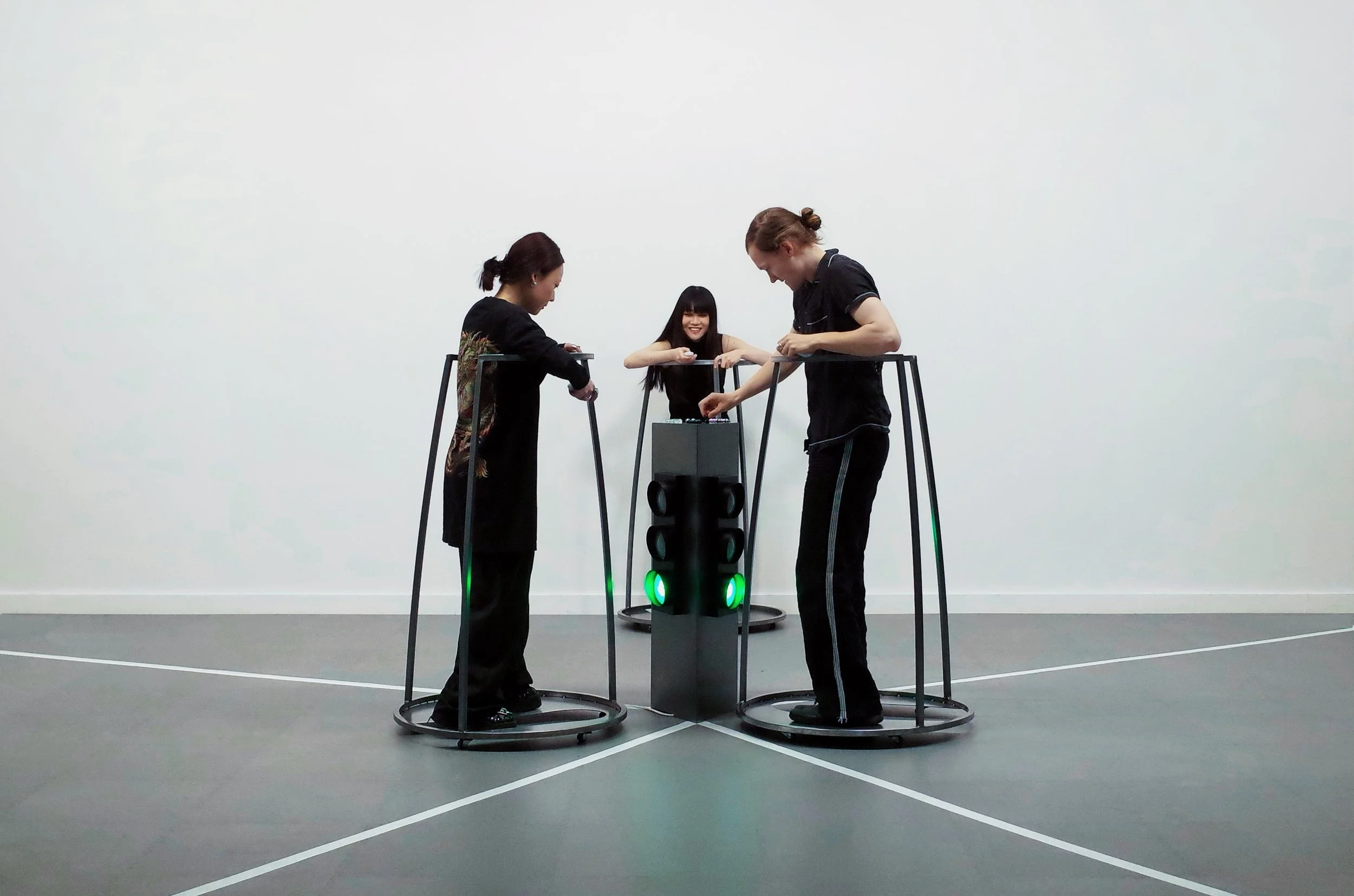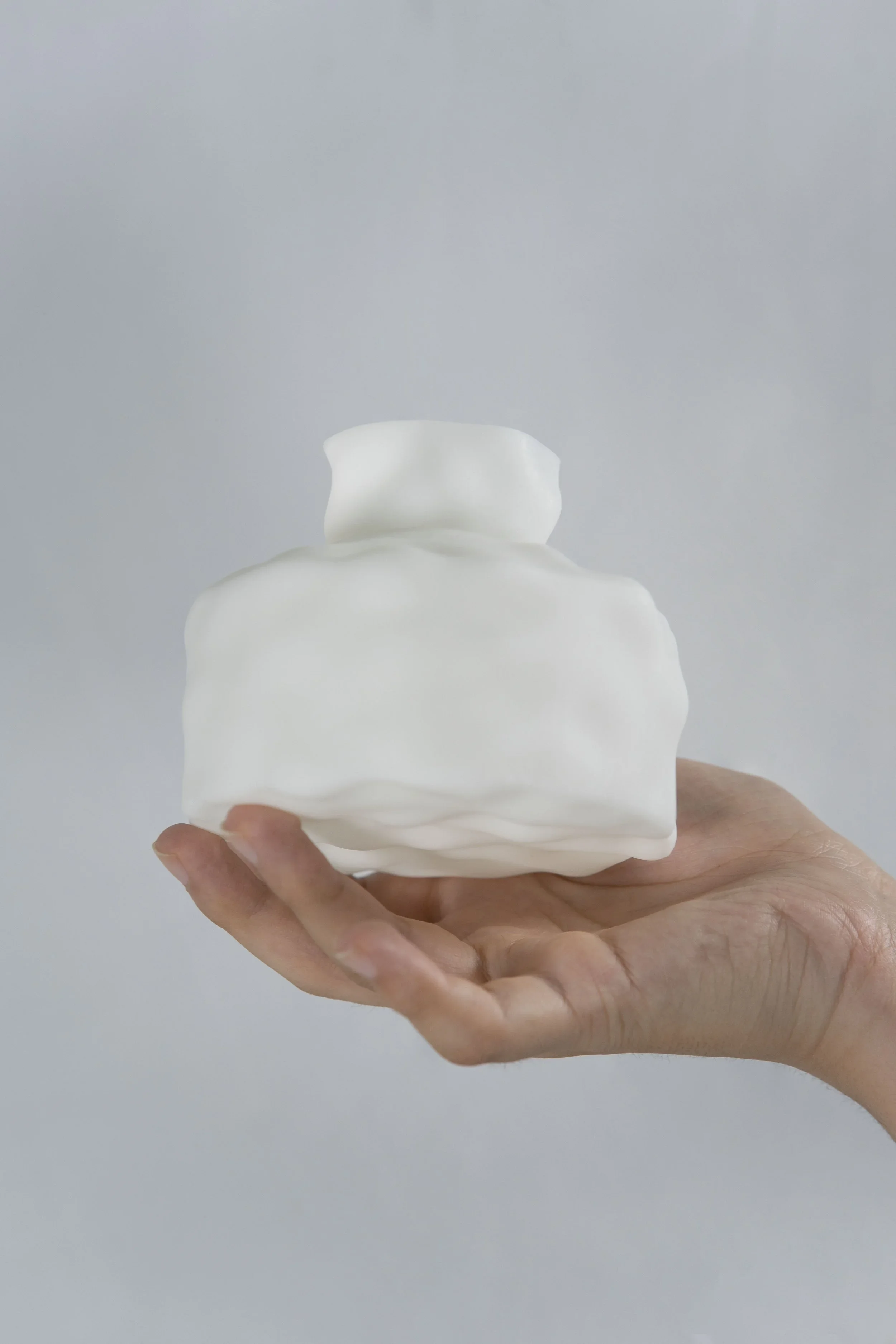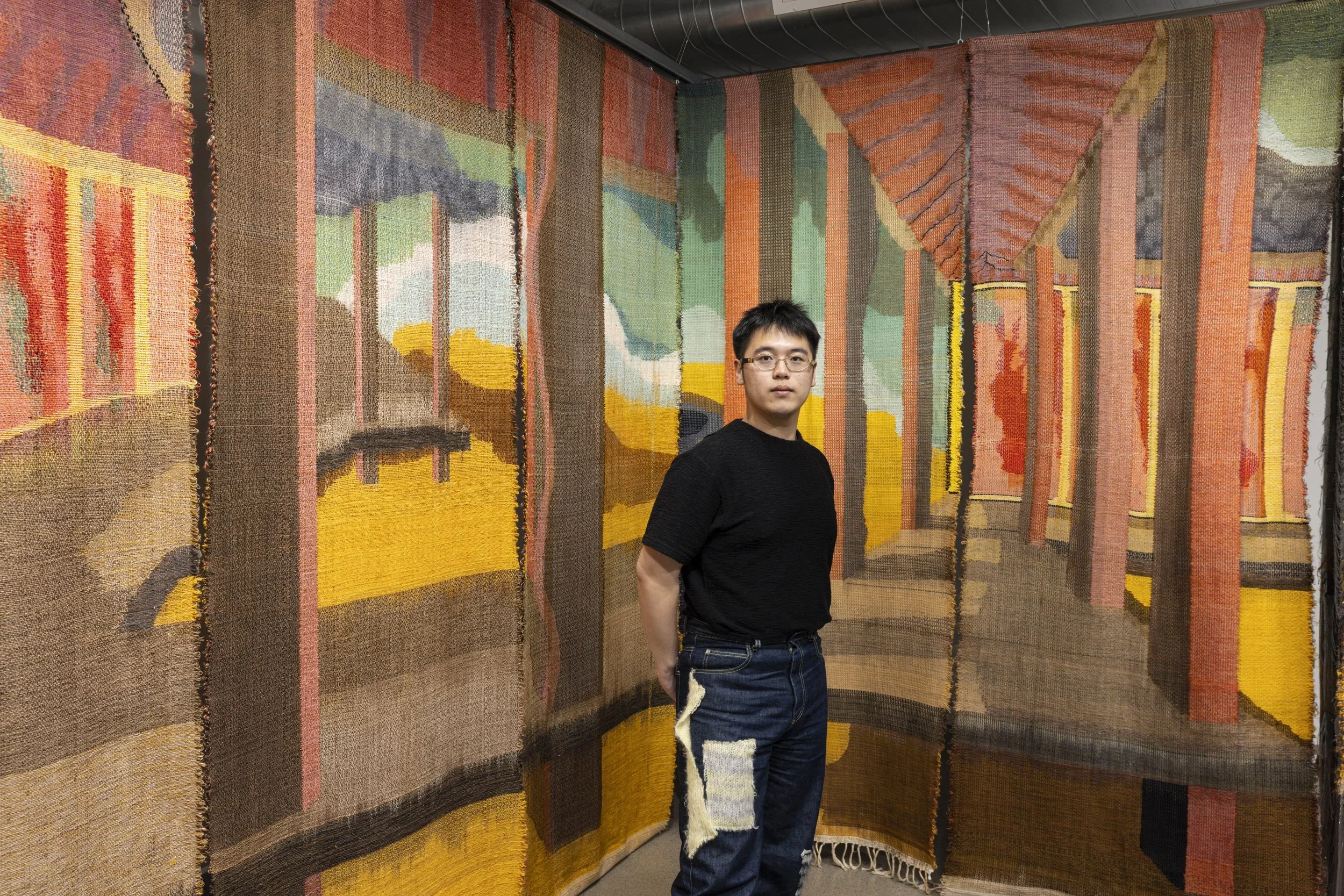10 Questions with Gumi Lu
Al-Tiba9 Art Magazine ISSUE16 | Featured Artist
Gumi Guihan Lu is an interdisciplinary artist, originally from Chongqing, China, and now based in New Jersey, USA. She holds a Master’s in Design and Technology from Parsons School of Design and a Bachelor’s in Computer Science from the University of Birmingham. In her work, Gumi explores choices and evolution in non-human-dominated scenarios by designing machines for extreme future settings. Her projects often use a first-person perspective, imbuing non-human entities with human emotions and attention. This creates a sense of vulnerability, loss, alienation, ambiguity, and regret, portraying a kind of embrace between humans and invisible life forms, grounded in solitude. Her art has been exhibited around the world, including at the CICA Museum in Korea, Le Carrousel du Louvre in Paris, and the Sasse Museum of Art in the US. Renowned art critic Anthony Fawcett has commended her work for its emphasis on movement, sequence, and spatial processes. He highlights how she incorporates the Japanese concept of “Ma” and uses light and space to create a profound sense of place.
Gumi Lu - Portrait
ARTIST STATEMENT
Gumi Lu is an interdisciplinary artist working at the intersection of technology, mythology, art, and culture. Her creative philosophy stems from a dual exploration of world order and personal memory, aiming to build a network of contrasts that are far removed from reality yet capable of explaining it. Inspired by ancient cultural memory devices that people compress history, culture, and ecology into physical entities that store and transmit information like crystals, she uses interactive technology, bioelectrical signals, quantum randomness, and other media to create encapsulated, 'non-present' worlds. The concept of 'Piñata,' in her works, serves as a gateway to future narrative realms, catalyzing a new, subtle consciousness through interaction. They act as proxies, guiding users to access future portals, retrieve details from other timelines, and shape their perspectives and attention to the world. Gumi's works aim to convey new, unexperienced memories to the viewers by weaving memory Piñata, which then re-enter reality, continuously proliferating, growing, and freely colliding. She hopes that through experiencing her works, the viewers can also explore the allure of fictional futures, and in doing so, gain new perspectives and awareness.
As Above, So Below, acrylic, aluminum, neodymium, PLA, PET, motors, electronics, 26x28x55 inches, 2023 © Gumi Lu
AL-TIBA9 ART MAGAZINE ISSUE16
INTERVIEW
Please introduce yourself to our readers. Who are you, and when did you first become interested in art?
Hi, I'm Gumi Lu. I'm an interdisciplinary artist from China, now living in New Jersey, USA, and I specialize in Fictional Futurism. I started writing fantasy stories in third grade and joined clubs for dubbing animations and radio dramas. By sixth grade, I was creating digital collages on my computer to tell stories visually. In middle school, I got into making composite images to express surreal ideas, designing covers for fantasy e-zines, and posters for theater festivals. Whether through writing, visuals, or sound, I've always loved diving into worlds far removed from reality. It made me seem pretty reclusive back then, but I really enjoyed it.
Your background in programming and genetic music is unique for an artist. How has this technical experience influenced your current artistic practice?
I've always loved math and physics, so I chose to study computer science in college. But I felt like an oddball there. Thankfully, Professor Peter Hancox understood my unique interests and became my mentor in the field of Computational Art. In 2017, I used machine learning algorithms to turn gene sequences into multi-track harmonic music. After that, I created a barcode player for gene music, sold gene testing kits, designed a vending machine that generates digital avatars, and developed an experience space for storing and accessing digital twins. If it were just about imagination, I could stick to writing or graphic design, but there's something special about creating interactive physical pieces. My technical experience keeps pushing me to do cool, interesting stuff. Plus, knowing the limits of technology just fuels my imagination even more.
Customized Biorhythm, acrylic, aluminum, neodymium, PLA, PET, motors, electronics, 71x40x27 inches, 2021 © Gumi Lu
In recent years, your work has focused on "exploring choices and evolution under non-human dominion," as you mention in your statement. What inspired you to delve into this theme, and how do you approach it in your creations?
Traditionally, we tend to think of society as moving forward in unison, with everyone heading in the same direction at the same speed. But in reality, human society is so diverse that different groups of people are living in different "times." Some people are experiencing a past that others have already moved beyond, while others are living in a future that some haven't reached yet. I believe that as the future unfolds, it's like squeezing various "futures" through a narrow pipe. The trend is to reduce the dominance of the mainstream and embrace more diversity. This means that fringe cultures and minority voices will have a place in the future. Even if people are in the same place at the same time, they will experience different "futures(yes, plural)."
So, I feel it's necessary to ask, 'What if not?' Imagine the existing political, economic, and social structures nearly collapsing or existing in a state of uncertainty—how would society's rebirth and the establishment of a new order come about? Where are the opportunities to restart from the ruins? Will new communities emerge, and will people begin to experiment with unprecedented ways of living? Will art, technology, and human collaboration take on entirely new forms?
In my work, I attempt to create a network of contrasts that are far removed from reality but can still explain the real world. In 'Customized Biorhythm,' set in the era of Generinature, plants' rights and rarity are determined by the extent of human intervention they receive. In 'Self Evolution,' people find themselves in a struggle between partial control and overall uncontrollability of the self as they use attention to create new species. In 'Gaze of Being,' unnamed biological entities merge their perceptions with their senses, with the present' me' superimposed on the past 'you,' projecting the survival choices of species through their gaze.
'As Above, So Below' amplifies the bioelectric signals of mammals, using them as micro-fractal switches to initiate cosmic processes, experiencing inevitable blockages and errors in material transitions. 'The Hand of Fate' explores the idea of humans hiding within the shell of a god to simulate and control human destiny using quantum randomness. In 'The Phosphorescence of Cosmic Magnetic Fields,' phosphorescence is carried into space, gradually degrading under high-energy UV and cosmic rays, becoming a trace of time.
Your works combine techniques and conceptual influences, drawing upon ancient Eastern philosophies and newer technologies. Can you share your thought process behind this unique approach?
I first heard the term 'Consilience' from Professor Anne Gaines. It's a concept introduced by the 19th-century British scientist William Whewell and later popularized by the American biologist Edward O. Wilson. Basically, it's about merging knowledge and insights from different disciplines, where evidence and theories from various fields support and validate each other to give a more comprehensive understanding of complex issues.
When I noticed the similarities between quantum states and the cosmic principles in the Tao Te Ching, I started thinking about combining these two fields. To understand what 'Tao' is and how it forms, as well as its connection to modern physics, I imagine 'Tao' as a multidimensional map. Energy becomes the coordinate points, the primal sparks from which everything else emerges. Rhythm, the harmonious oscillation of existence, acts as the axis of the universe's rotation. The network is the final stage, illustrating how the world's rhythms come together and operate smoothly.
Everything exists within a dynamically connected framework; nothing is isolated. Through continuous interactions over time and space, each harmonious flow contributes to forming a 'collective consciousness field.'
Customized Biorhythm, acrylic, aluminum, neodymium, PLA, PET, motors, electronics, 71x40x27 inches, 2021 © Gumi Lu
Customized Biorhythm, acrylic, aluminum, neodymium, PLA, PET, motors, electronics, 71x40x27 inches, 2021 © Gumi Lu
Ultimately, what would you like to communicate with your work? What messages would you want to convey, and what impact do you wish to have on viewers?
We all know that the body is an extension of the mind, like an external crystal. Just as events, people, and objects from the past can serve as crystals that unfold historical narratives, "plural", futures can also be stored in human memory through the creation and Descartes' "intuition." To better distinguish between events that have actually happened and those remembered after accessing the crystal, I call the gateways to future scenarios or stories "Piñatas."
For example, when a visitor buys a cup from the gift shop after attending an exhibition, that cup becomes a crystal. Through this small object, the visitor can recall the exhibition they saw. The artworks in the exhibition are the Piñatas. Through the Piñatas, the audience can wander in this encapsulated, "non-present" world.
A piñata is a Latin American decoration filled with candy and toys, usually hung up during festivals and parties. Participants are blindfolded and take turns hitting it with a stick until the treats inside spill out. Piñatas connect reality with imagination and memory with the future. By hitting a piñata, you can tap into a whole hidden world without even seeing it.
In my work, I create memory piñatas as a sort of cross-temporal social experiment. The idea is to send new, unexperienced memories to viewers. When people engage with the piñata, their perception of the real world blends with the artwork, sparking a new, subtle consciousness. This lets them bypass time, open doors to the future, and retrieve details from another time and place, forming their own perspectives and attention.
This instinct is activated through repeated experiences of encoding, storing, and retrieving. So, an alternate future can become a real memory.
From spatial construction to eco-intelligence networks and from multidimensional existence to new social forms, each regenerated memory acts as a node in our collective wisdom. I hope Piñatas can serve as launchpads for these nodes, letting them proliferate, grow, and collide freely like balls in a Plinko game. Whether it's future scenarios, uncertain events in parallel timelines, or stories from unexplored domains, creating and encapsulating new memories isn't just about exploring the unknown. It also gently nudges our understanding of the present, becoming an internalized consciousness that informs our choices.
Speaking of your work, the project As Above So Below incorporates principles from Tao philosophy into a complex kinetic sculpture. Can you elaborate on how Taoist concepts are used in this piece?
Laozi believed that things happen spontaneously. He compared our universe to a bellows. It might look empty inside, but it keeps generating new energy. The bellows have a rhythm of exhaling and inhaling. As long as you don't disrupt that rhythm, everything keeps going. Laozi wasn't interested in fixing things in a specific state but in their constant movement and cycles. The Tao endlessly distributes and reclaims resources. Instead of trying to fix something in one state, it's all about flexibly speeding up or slowing down the cycle.
Things tend to follow repeating patterns that show up at different levels. The constant process of input and output creates diverse ecosystems. Evolution happens over time in a balanced way. Nature shows rhythmic patterns governed by basic principles and laws, like heartbeats, tides, and bird migrations. These phenomena reveal the influence of the Tao. In the same way, the recurring cycles of water, nutrients, and ecological communities show how these patterns maintain the delicate balance of the Tao.
As Above, So Below, acrylic, aluminum, neodymium, PLA, PET, motors, electronics, 26x28x55 inches, 2023 © Gumi Lu
As Above, So Below, acrylic, aluminum, neodymium, PLA, PET, motors, electronics, 26x28x55 inches, 2023 © Gumi Lu
As Above, So Below involves dynamic sets of neodymium and biocurrents. Can you explain the technical process behind the creation and functioning of this piece? What inspired you to follow this route?
I used stick-on silver chloride (Ag/AgCl) electrodes to collect EMG signals from a person's skin and then used an amplifier circuit to drive a motor with those signals. Since live data collection can be a bit chaotic, I saved the bioelectric current data in EEPROM to use as startup data. The motor drives a neodymium magnet, which disturbs the magnetic field in a small area. The changes in the magnetic field then alter the speed of the next motor layer. I want to use a real living entity as the initial driver of the magnetic field, so I digitized a typical form of life expression and "injected "it into mechanical and analog devices.
Interactivity and the viewer's perspective seem to play crucial roles in your work. How do you envision the audience engaging with As Above, So Below, and other interactive pieces?
Technically, it's a kinetic sculpture, but during the performance, it can collect the audience's EMG data to drive the initial magnetic field. The whole setup is a metaphor for the different layers of the world. The audience isn't just interacting with objects; they're actually activating a real living system.
As Above, So Below, acrylic, aluminum, neodymium, PLA, PET, motors, electronics, 26x28x55 inches, 2023 © Gumi Lu
Your work is strictly related to the future. What do you think is the role of art in shaping the future of our society? Can art have a lasting impact?
My field of study is fictional futurology. Unlike theoretical or applied futurology, it doesn't directly impact current decision-making, management, or development strategies. It's about creating and exploring pure possibilities, independent of the discoverer and the means of fiction. Fictional futurology is mainly presented through science fiction, literature, theater, and various forms of art. This field doesn't rely on empirical evidence but rather on a clear, intense focus that captures imagery. It's similar to Descartes' concept of 'intutio,' where he said, 'Among my ideas, some appear to be innate, some to be adventitious, and others to have been invented by myself.' Imagery is comprehended instantly and wholly, not deduced step by step, which differentiates fictional futurology from other types. Most importantly, imagery can only be given, so what fictional futurology does is more about translating these visions rather than inventing them.
Martin Heidegger said, 'The essence of technology is nothing technological. The essence of technology is a way of revealing.' In the original German, he uses 'Entbergen' to describe the process of truth (Aletheia) being revealed or uncovered. Aletheia, the Greek term, is used to express the concept of truth as unconcealment. Technology, as a way of revealing, transforms the raw elements of the real world into forms we can understand and use. Fiction, on the other hand, presents pure possibilities in the 'debate of truth' rather than being a direct representation of it.
Take, for example, the phlogiston theory and the ether hypothesis. Even though they were eventually disproven, they still pushed scientific progress and our understanding forward. The key point is that we don't know the full truth; we only see small parts of it. So, understanding truth involves engaging in this ongoing debate. In the same way, art needs to imagine extreme and fringe futures, focusing on possibilities that mainstream narratives often ignore or marginalize. Some futures may seem out of reach now, but their very existence helps us reconsider the process of the 'debate of truth.
Lastly, talking about the future, what are you working on at the moment? Do you have any new projects you would like to share with our readers?
Recently, I've been working on a device for fear desensitization, and a forehead vibration assist for a VR headset. These projects are designed to explore mental imagery and virtual boundary navigation, respectively. I look forward to sharing these works with everyone soon.


























